|
[Front Page] [Features] [Departments] [SGAP Home Page] [Subscribe]

Short Cuts
Readers are invited to submit short items of interest about Australian plants to be included here. If submitting non-original material (eg newspaper or magazine cuttings), please also advise if the author has given permission to republish and, if not, please provide a contact address so that permission can be sought.
Short Cuts in this issue:
 Direct Tree Seeding for Reafforestation Direct Tree Seeding for Reafforestation
- A range of issues can effect the success of this process.
 Would the real Callistemon 'Captain Cook' please stand up? Would the real Callistemon 'Captain Cook' please stand up?
- Inappropriate propagation methods make life difficult.
 After the Virus After the Virus
- The effect of Rabbit Calicivirus on native vegetation.
 The Value of a Tree The Value of a Tree
- How much is a tree worth?? Probably more than you think.
 Beaufortia and The Duchess of Beaufort Beaufortia and The Duchess of Beaufort
- One of the few genera named in honour of a woman.
 A Remarkable Red Wattle A Remarkable Red Wattle
- A red wattle??!! And not a paintbrush in sight!
 
Direct Tree Seeding for Reafforestation
Direct application of tree seeds to a site should be an economical process. However, as Mark Burns explains, dormancy and other factors have a significant bearing on success or failure.
Most Australian trees reproduce themselves by producing seeds which fall to the ground and are spread through different means. As Australian conditions are often harsh as a result of prolonged drought, wildfire or extremes of weather, many seeds have inbuilt dormancy mechanisms which prevent or delay their germination over time. Some need to be scorched by fire or digested by animals, while others simply work on the law of probability, whereby they produce many millions of seeds in the hope that one seedling will survive and grow into a mature tree.
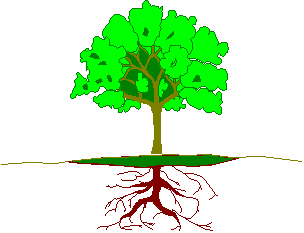 
As natural and obvious as these processes are, the use of direct tree seedling, particularly as a reafforestation technique on mines, quarries and other disturbed sites, has been slow to be understood and to gain acceptance in Australia. The reasons for this are numerous and relate to a failure to understand dormancy mechanisms in some cases, the co-use of exotic pasture species which quickly kill young native trees and shrubs, and a feeling that the processes of seeds are mysteriously leading to a consequent unnecessary search for complicated and hi-tech answers. While the dormancy processes of some species are not well understood, many common tree and shrub species germinate readily when applied to bare earth with minimal or no seed treatment.
Most tropical Eucalyptus species will germinate and grow quickly without any pre-treatment, if soil moisture and temperature conditions are right, and if there is no grass or weed competition. Grass/Weed competition is the single most important factor responsible for the failure of many direct tree seeding projects.
Most native tree and shrub species establish slowly (compared to exotic grasses) and experience protracted root development, having small soil root volumes compared to grasses. They compete poorly with quicker growing grasses and weeds. It should be remembered that native tree seeds have adapted to falling into and establishing in native grasslands and understorey over millions of years.
Native grasses are mostly tufted (not stoloniferous) and often at low densities, with bare patches of ground in between. Exotic grasses, such as kikuyu, Rhodes and buffalo grass, form dense swards and compete vigorously for soil moisture, nutrients and space. Direct seeding was commonly used on farms in Australia for windbreak establishment up until the mid-1950s and then disappeared as a tree establishment technique. This may have been caused by the advent of exotic pasture species.
Most Acacia species have a hard seed coat. If this coat is damaged by scarification or dipping in boiling water, the seed germinates more rapidly and uniformly than untreated seed. In so doing, we are only replicating the processes of fire and abrasion in nature. A good example of the effect of abrasion is the prolific germination of many desert species in wheel tracks in outback areas.
Eucalyptus and Acacia seeds are most commonly used for rehabilitation of mines and quarries due to their reliability and simple pre-treatment needs, and also their availability from suppliers in bulk at a relatively low cost. However, to successfully tree seed a site, other basics (other than seed dormancy and weed competition) need to be considered. These include ground disturbance (cultivation), time of sowing, fertilisation requirements. And adequate sowing rates. |
 
|
On many sites I use a large dozer with long rippers to prepare the ground. It doesn't look very neat initially, but trees love it and quickly establish deep roots. Soil water infiltration is improved. The presence of rocks is often an advantage, as they can shelter young seedlings and provide a diversity of micro-habitats.
Time of sowing is relevant to temperature and rainfall. All seeds have a minimum germination temperature. Some species may not germinate in winter. If seed remains ungerminated for extended periods, the risk of removal by ants and other insects increases. In forest situations, much of the seed that falls to the forest floor is quickly harvested by ants. It is not unusual to see young seedlings emerging out of ant holes after rain. Ants are not such a problem on freshly disturbed mines and quarries.
Fertiliser is not as important as many people think, although it is useful in expediting growth and the development of a healthy root system on poor sub-soils and overburden material. Nitrogen and phosphorus are the two critical nutrients, although the addition of sulphur can also be beneficial.
Sowing rates vary with species. Care must be taken not to sow more aggressive species too heavily.
Other factors can be involved, but understanding and implementing the above basics will help ensure success.
The more I work with native tree and shrub seeds, the more I appreciate the resilience, complexity and wonder of natural systems. Japanese palaeontologists have found and germinated 1,000 year old Lotus seeds found in tombs in Manchuria in the 1950s. What an amazing feat to keep the spark of life alive in something so small for so long.
From the March 1998 issue of the "Bulletin", the quarterly newsletter of the Queensland Region of SGAP.
Mark Burns is a director of Global Soil Systems.
[ Return to Index ]

Would the real Callistemon 'Captain Cook' please stand up?
If your "Captain Cook" bottlebrush no longer qualifies for the term "low growing", Byron Williams may know the reason.
This well known popular small Callistemon cultivar has been available through the nursery trade since 1971. These days Callistemon viminalis 'Captain Cook' is one of our best known bottlebrushes, being available at most nurseries and also at the larger super markets and hardware stores.
Unfortunately, some time after its release, you could not always be sure that plants with the label Callistemon 'Captain Cook' were correctly identified. Many plants were grown from seed from the original 'Captain Cook' cultivar and distributed under that name. To further confuse things, cuttings were also taken from those seedlings and also distributed and marketed as the real cultivated variety 'Captain Cook'. Thus the true Callistemon'Captain Cook' cultivar became difficult to obtain because sound horticultural practice was not followed by a minority of growers.
It is important that all cultivated varieties of native plants are propagated vegetatively if the true special features of the cultivar are to be retained. This is particularly important with cultivars of callistemons because the chances of obtaining hybrid seed is so very high.
The original Callistemon 'Captain Cook' originated in Queensland from a batch of Callistemon viminalis seedlings. One particular plant was found to be more dwarf and bushy than the others and developed lots of flower buds at a young age. Propagation by cuttings was started and a stock of young plants was gradually built up. It was originally marketed under the name Callistemon 'Compacta'.
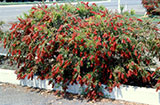 |
The low, slightly weeping habit of the true Callistemon 'Captain Cook'.
Select the thumbnail image or plant name for a higher resolution image (60k).
|
At the 1969 Annual Nursery Industry Conference this cultivar was nominated for and won the first Shrub of the Year award. It was decided at the Conference to name the new cultivar Callistemon viminalis variety 'Captain Cook' to commemorate the 1970 Bicentenary celebrations, in honour of Captain James Cook.
Many people don’t realise that unlike the many dwarf and large growing rogue 'Captain Cook' seedlings previously marketed, the true Callistemon 'Captain Cook' cutting grown cultivar is a medium sized shrub growing to 2metres (sometimes a little higher) with a slight weeping habit. The lanceolate leaves are light green, the new growth being tinged with reddish pink leaf tips. In October an abundance of red flowers speckled with yellow anthers, cover the bush. It is a truly lovely bottlebrush in its true original cultivar form.
Hopefully those Callistemon 'Captain Cook' plants now available are true to the name.
For those members who are interested in history, a semi advanced plant of C.'Captain Cook' was presented to the then Governor of Victoria, His Excellency Sir Rohan Dalacombe, in Melbourne in March 1970, for planting in the grounds of Government House. Our friends at the Botanical Garden in Melbourne might be able to tell us whether the plant is still there. (I‘ve still got mine!)
From the September 1998 issue of the newsletter of SGAP's Victorian Region.
[ Return to Index ]

After the Virus
The release of Rabbit Calicivirus (initially inadvertently) greatly reduced rabbit numbers in some districts and resulted in the regeneration of native species. Eleanor Handreck reports.....
 
Glossary:
Rabbit Calicivirus (RCV) = the name of the virus.
Rabbit Calicivirus Disease (RCD) = the name of the disease that is caused by the virus.
* * * * *
Have you ever wondered what effect, if any, the release of the Rabbit Calicivirus (RCV) from Wardang Island in October 1995 has had on South Australia's native vegetation? An article which appeared in the Spring 1997 issue of Ecos (a CSIRO quarterly publication) has some answers to that question. (The information is used with permission). Greg Mutze, of South Australian Animal and Plant Control Commission, supplied additional detail and gave helpful advice.
It took just two months for Rabbit Calicivirus Disease to reach a rabbit monitoring station in the Flinders Ranges. Within four weeks of its detection there, 95% of the local rabbit population had died. By late 1997, the population had recovered somewhat to stabilise at about 10% of its original size.
Over that same two year period, the number of perennial plants that were present in a series of monitored sites had increased substantially. Some perennial seedlings were being seen in the area for the first time in decades. Such species managed to persist only because of the longevity of adult plants.
Since 1992, officers with the South Australian Animal and Plant Control Commission had been collecting data every 6 months from twenty four 100 m x 4 m quadrats in the Flinders Ranges National Park (FRNP) and the adjoining section of Gum Creek Station, a sheep grazing pastoral property. The whole area had been severely degraded by extensive sheep stocking last century. The arrival of rabbits closely followed this initial damage. Half of the above quadrats were within experimental blocks of 4 km from which rabbits have been removed by "ripping" all rabbit warrens. Even before the RCD (May 92 Nov 95), perennial plants were found to be increasing in abundance in the areas from which rabbits had been removed. There had been an increase of about 17% per annum in the total number of moderately palatable (to rabbits) perennials such as Acacia victoriae, Senecio magnificus, Ptilotus obovatus, Cymbopogon ambiguus, Atriplex stipitata and Aristida nitidula, while there was a fall of about 5% in the unprotected areas (rabbits were present). Post RCD, there was a further 11% increase in the total number of these plants in the protected areas. In unprotected areas, where there were still some rabbits present, there was a 17% increase in total numbers.
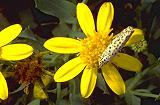 |
Senecio magnificus is a colourful daisy of the Flinders Ranges.
Select the thumbnail image or plant name for a higher resolution image (32k).
|
One very encouraging aspect of the results from this study has been that, on Gum Creek Station, the "moderately palatable" plants are recovering at a rate that is similar to that on FRNP Gum Creek has continued to be grazed by sheep. Although stocking rates have not changed, the sheep have been spending more time in the part of the paddock that is being studied, and which had previously been badly rabbit infested.
After the arrival of RCD, new photopoint quadrats were established to monitor the changes in the abundance of the plants that were most sensitive to rabbit grazing. Many of these plants had become extremely rare, and were not being recorded at all in the previously established quadrats. Recruitment of seedlings of species such as Maireana astrotricha (Low Bluebush), M.sedifolia (Pearl Bluebush), Eremophila alternifolia and Acacia oswaldii have been recorded on FRNP. Recovery from previous rabbit grazing (which had kept some plants pruned to less than 40 cm high) and extensive set in mature plants of up to 40 cm in height has been recorded for rabbit palatable plants such as Maireana (7 spp.), Hakea leucoptera, Solanum sp., and several Acacia spp. Recruitment of Alectryon oleifolius (Bullock bush) and Eremophila longifolia root suckers has occurred in all areas, but A.oleifolius suckers are being severely stunted by grazing sheep on Gum Creek Station. But it may be several years before the slow growing perennial plants of the semi arid zone are safe from browsing animals. It is possible that many of the most palatable species are so rare that they will rebound only slowly, if at all.
It is far too early to gauge the long term effect on our native plant species of lower rabbit numbers. But some effects are visible to the naked eye. Late last year, when it was already 6 months since the last good rain, there was an abundance of dry feed. In the past, rabbits would have eaten the area to bare ground.
If the vegetation and land is to fully recover, it is essential that the decline of rabbits is not fully replaced by increasing numbers of stock, kangaroos or goats. In South Australia, the maximum stock limits which are set out in lease agreements offer some protection to the land. The easing of rabbit grazing will give graziers more flexibility in the way that they manage their land.
The RCD will never totally eradicate rabbits. Its effect may begin to wane after only five or ten years. The best control of rabbits will certainly occur where mechanical means of rabbit control such as warren ripping are carried out in conjunction with the virus. Otherwise, the respite from the depredations of rabbits that our native plants are now enjoying may be only temporary!
From the August 1998 issue of the newsletter of SGAP's South Australian Region.
[ Return to Index ]

The Value of a Tree
How much do YOU think a tree is worth?? And how does one measure the value and then convert the result to monetary terms? Here's one way.....
When Sue Rostas, Communications Officer for the Kooragang Wetland Rehabilitation Project received a letter from Carrington Public school student, Michael Wilson, it set her thinking.
Michael asked what was the economic value of a tree. He suggested we assume a value of $1 a day for the amount of oxygen that a tree produces. A tree thus produces $365 worth of oxygen per year or a total of $36,500 over 100 years (and that's not allowing for inflation!)
Sue wondered how close to the mark was this assumed dollar value. A few phone calls to Assoc. Prof. Tlna Offler, University of Newcastle and Bill Nethery, State Forests of NSW plus some library work revealed some startling but often overlooked facts about the true value of trees.
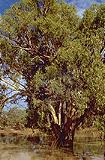 |
The river red gum, Eucalyptus camaldulensis at Menindee Lakes. How much is it worth?
Select the thumbnail image or plant name for a higher resolution image (57k).
|
Michael's assumption had in fact greatly underestimated the value of trees. The true value (considering only oxygen output) of a tree such as a Red Cedar would be about $120,000 each year (see box). If the tree
lived 50 years it would have produced about $6 million worth of oxygen!!
The world would indeed be in deep economic trouble if we had to pay for the oxygen a tree produces.
This calculation of the value of a tree has been based solely on its net oxygen output. But trees also have economic value in a number of other ways:
- They reduce the water table level and hence reduce soil salinity, which in turn improves the soil's ability to grow plants.
- They act as a carbon sink, using up considerable quantities of carbon dioxide, thus reducing the level of greenhouse gases in the atmosphere.
- Oh, and by the way, they produce a valuable building material - timber.
A 50 year old Red Cedar would yield about $5000 worth of timber - this is the only factor usually considered when determining the economic value of a tree. As you can see this pales into insignificance compared to the value of the oxygen the tree gives us free of charge !
Commercial cost of oxygen
7.9 litres (9.0 kg) of oxygen costs $54.
From this we can calculate that 5 mole oxygen costs $1.
Value of net oxygen output of a tree such as red cedar
Trees produce approx 5 mole (a measure of the number of molecules) oxygen per square metre leaf area per day.
Trees use about half this oxygen for their own respiration.
Therefore, the net oxygen output of a tree is approx 2.5 mole per square metre leaf area per day.
For tropical rainforest the average total leaf surface area is about 8 times the area of the canopy.
A 5 year old red cedar has a canopy of about 7 square metres and hence a net oxygen output of 2.5 x 8 x 7 = 140 moles worth $28 per day (about $10,000 per year).
A 20 year old red cedar has a canopy of about 80 square metres and hence a net oxygen output of 2.5 x 8 x 80 = 1600 moles worth $320 per day (about $120,000 per year).
By the time the tree is 50 years old it would have produced oxygen worth about $6 million!
NB The above calculation is a rough estimate assuming 10 hours of sunlight per day and "typical" levels of water, light, temperature and nutrients.
|
Media Release of 24 July 1998 by the Kooragang Wetland Rehabilitation Project, Newcastle, New South Wales.
[ Return to Index ]

Beaufortia and The Duchess of Beaufort
It seems that few plants have been named in honour of women. Beaufortia is one exception, as Len Stephenson has discovered.
Historical and botanical books do not usually recall great contributions to botany by women. Women obviously made their contributions in the eighteenth and nineteenth centuries, when most of the now-known genera were named, but, either their contributions were played down, or they did not contribute to an extent comparable with the botanical greats, such as Banks, Brown, Solander etc.
Thus, it is unusual to find a woman's name commemorated in a plant's generic name. One exception is in the Australian genus Beaufortia. Mary Capel, daughter of Lord Arthur Capel, was born in 1630. On 17 August 1657 she was married to Henry, the third Marquis of Worcester, having already been widowed by the death of her first husband, Henry Seymour, Lord Beauchamp.
The Marquis was then Lord President of Wales and Lord Lieutenant of North and South Wales. In 1682 he was elevated to the dukedom, and became the Duke of Beaufort. Mary Capel, the daughter of a lord of the realm, became successively Lady Beauchamp, the Marquise of Worcester and, finally, the Duchess of Beaufort.
Following the accession to the British throne of William III in 1689, the Duke refused to subscribe to the oaths of allegiance to the new monarch, and, thereafter, he resigned all office and lived in retirement. Not a great deal is recorded of the Duchess by biographers, but it is known she bore the Duke four daughters and two sons, and that she maintained extensive gardens at her two homes, one at Chelsea and the other at Badminton.
She is known to have done some interesting paintings of flowers and she formed an extensive collection of paintings and drawings made by others. She obviously devoted much time to her botanical pursuits and, although she does not appear to have published any botanical works, her very large herbarium collection was made available to botanists of her time, and her collection now resides in the Herbarium of the British Museum. The Duchess died at the home at Badminton on 7 June 1714, and her name is honoured and her contributions recognised in the name Beaufortia, a genus known only in Australia.
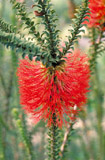 |
Beaufortia was named by Robert Brown in 1812. It is small genus of about 16 species all confined to south-Western Australia. This is Beaufortia decussata
Select the thumbnail image or plant name for a higher resolution image (30k).
|
From the June 1998 issue of the newsletter of the Victorian Region of SGAP.
The article came from a booklet "What's in a name" by the late Len Stephenson of SGAP South Australia Region on the derivation of generic names of Australian native plants and originally appeared as articles in the SGAP South Australia Journals from 1972-1987.
[ Return to Index ]

A Remarkable Red Wattle
A red-flowered wattle?? And it's not even April 1.
About 950 species of the Acacia genus are growing in Australia. The colour of their flowers ranges from almost white, through cream, lemon, to rich gold (One Queensland species, A.purpurapetala, has pink flowers...ed). The golden wattle is recognised world wide as an emblem of Australia.
About four years ago, bushwalkers in a state forest 40km north of Melbourne discovered a single specimen of a wattle which they described as having flowers of "a spectacular crimson colour".
News of the discovery was kept secret, except for a few people in horticultural circles, and its existence has
only become general knowledge in recent months.
David Cameron, a senior botanist involved with threatened flora and fauna research at the Arthur Rylah Institute for Environmental Research in Melbourne, and Bill Molyneux, Australian native plant expert and botanist, visited the site of the original specimen in the wild and collected 12 cuttings.
Sadly, the original specimen of the wattle, a 1.9 metre form of the Cinnamon Wattle, Acacia leprosa, is now dead. Some horticulturists speculated that the red wattle might have been lost for ever. Fortunately, the Royal Botanic Gardens in Melboume have reported that they have two plants that are very healthy and very happy and more cuttings have been taken from these plants.
There are few doubts that this wattle would have an exciting future, with the potential to provide an immense marketing coup for Australia. However, ownership and Plant Breeder's Rights have to be established and sufficient stocks be propagated to ensure a commercially viable operation.
This red form of Acacia leprosa is probably the result of a genetic mutation; so that seeds from the red plant are unlikely to produce red offspring. The only way to multiply the red form is from cuttings from the original plant, or perhaps by cloning cells by tissue culture techniques.
From the January 1998 issue of "Brigge", newsletter of the Burrendong Arboretum Association.
[ Return to Index ]
 
[Front Page] [Features] [Departments] [SGAP Home Page] [Subscribe]
Australian Plants online - December 1998
The Society for Growing Australian Plants
|